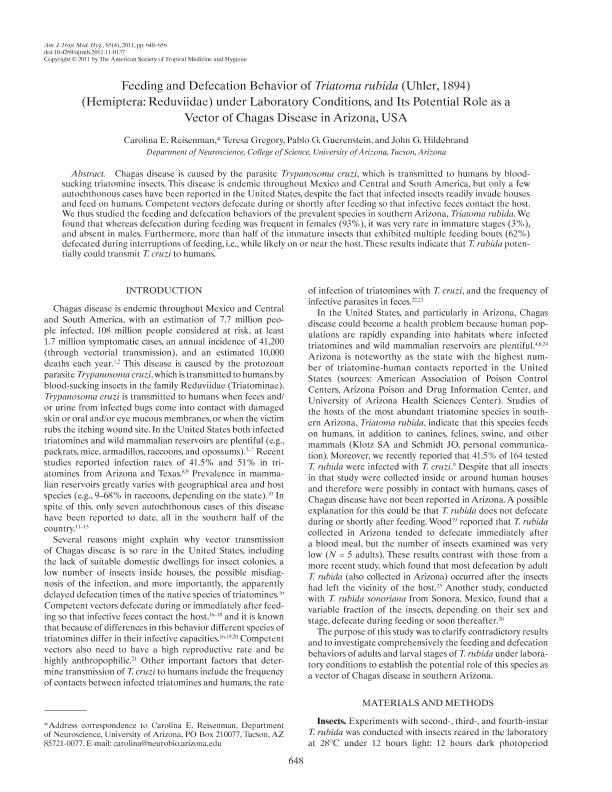Artículo
Feeding and defecation behavior of Triatoma rubida (Uhler, 1894) (Hemiptera: Reduviidae) under laboratory conditions, and its potential role as a vector of chagas disease in Arizona, USA
Fecha de publicación:
10/2011
Editorial:
American Society of Tropical Medicine and Hygiene
Revista:
American Journal of Tropical Medicine and Hygiene
ISSN:
0002-9637
Idioma:
Inglés
Tipo de recurso:
Artículo publicado
Clasificación temática:
Resumen
Chagas disease is caused by the parasite Trypanosoma cruzi, which is transmitted to humans by blood-sucking triatomine insects. This disease is endemic throughout Mexico and Central and South America, but only a few autochthonous cases have been reported in the United States, despite the fact that infected insects readily invade houses and feed on humans. Competent vectors defecate during or shortly after feeding so that infective feces contact the host. We thus studied the feeding and defecation behaviors of the prevalent species in southern Arizona, Triatoma rubida. We found that whereas defecation during feeding was frequent in females (93%), it was very rare in immature stages (3%), and absent in males. Furthermore, more than half of the immature insects that exhibited multiple feeding bouts (62%) defecated during interruptions of feeding, i.e., while likely on or near the host. These results indicate that T. rubida potentially could transmit T. cruzi to humans.
Palabras clave:
Chagas Disease
Archivos asociados
Licencia
Identificadores
Colecciones
Articulos(CICYTTP)
Articulos de CENTRO DE INV.CIENT.Y TRANSFERENCIA TEC A LA PROD
Articulos de CENTRO DE INV.CIENT.Y TRANSFERENCIA TEC A LA PROD
Citación
Reisenman, Carolina Esther; Gregory, Teresa; Guerenstein, Pablo Gustavo; Hildebrand, John; Feeding and defecation behavior of Triatoma rubida (Uhler, 1894) (Hemiptera: Reduviidae) under laboratory conditions, and its potential role as a vector of chagas disease in Arizona, USA; American Society of Tropical Medicine and Hygiene; American Journal of Tropical Medicine and Hygiene; 85; 4; 10-2011; 648-656
Compartir
Altmétricas




